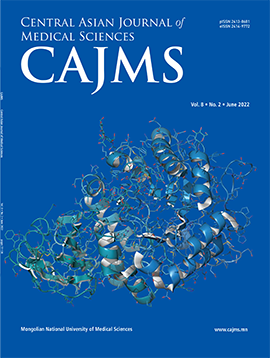Facial Soft Tissue Profile Analysis in Mongolian Children
DOI:
https://doi.org/10.24079/cajms.2020.12.002Keywords:
Cephalometry, Maxillofacial Development, Reference Standards, Orthodontics, MongoliaAbstract
Objectives: The present study aimed to evaluate the specific variables of facial soft tissue changes in Mongolian children using angular and linear measurements. Methods: We studied the lateral cephalograms of 541 subjects (228 male and 313 females) having normal occlusion between the ages of 6 and 15 years. Two orthodontists read all radiographs to determine their cerebral vertebral maturation index (CVMI). The radiographs were digitized and cephalometric measurements were made. Results: The Gl'-Sn-Pg' angle for all participants was 170.2 ± 5.4°. The Nasofrontal Gl’-N’-Tn’ angle was 147.2 ± 7.6° for all participants. It decreased with CVMI stage for girls (p = 0.000). The Nasofacial angle Tn- N'- Pog' angle averaged 20.4 ± 7.7° for all participants. The Nasomental angle N'- Tn-Pog' angle on averaged 144.9 ± 4.3° for all participants. It decreased with the CVMI stage for girls (p = 0.000). The Mentocervical Tn-Pog Me-NTP angle was significantly larger in boys than girls (107.8 ± 8.6° vs. 105.3 ± 7.8°, p = 0.001). The Nasolabial angle Ls-Sn-Col angle averaged 100.8 ± 10.6° for all subjects. It decreased with the CVMI stage for both boys (p = 0.043) and girls (p = 0.021). The distance between the E line and TUL was significantly larger in boys than girls (1.7 ± 2.1 vs. 1.2 ± 2.0 mm, p = 0.004). It also significantly decreased with the CVMI stage for both boys (p = 0.033) and girls (p = 0.000). The space between the E line and TLL averaged 1.9 ± 2.0 mm for all subjects. It did not differ by gender. However, it decreased with the CVMI in both boys (p = 0.022) and girls (p = 0.006). Conclusions: We have provided important results for comparing cephalometric soft-tissue values in Mongolian children in this study. These results provide a valuable guide for orthodontic diagnosis and treatment in our country.
Downloads
231
Downloads
Published
How to Cite
Issue
Section
License
Copyright (c) 2020 Mongolian National University of Medical Sciences

This work is licensed under a Creative Commons Attribution-NonCommercial 4.0 International License.




